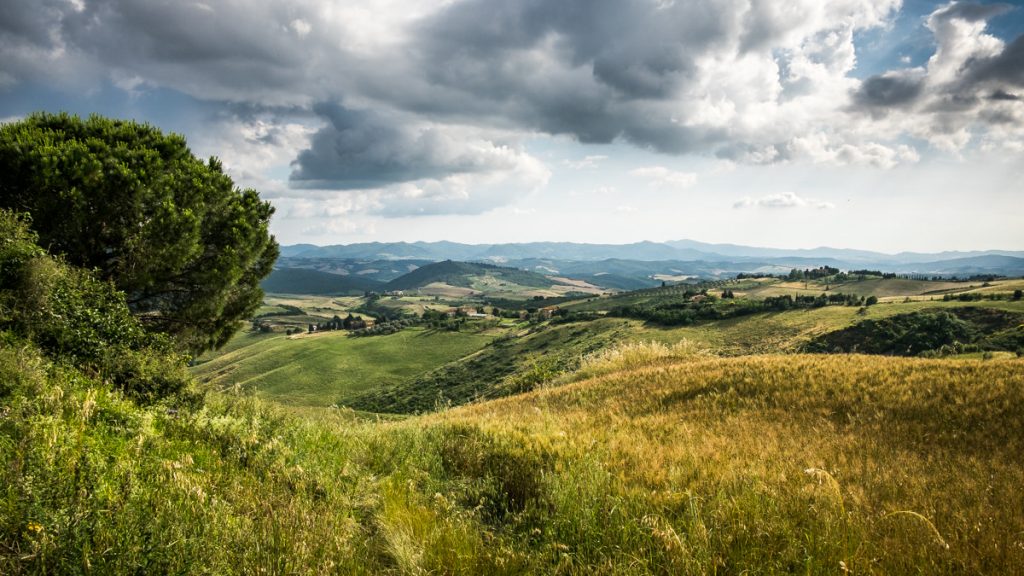Introduction
Fiontian. “Algeria Sahara Desert Photo From Drone.” Wikimedia Commons, 14 October 2014, commons.wikimedia.org/wiki/File:Algeria_Sahara_Desert_Photo_From_Drone_5.jpg. Accessed 4 Dec. 2021. (Title mine)
The Horse and His Boy follows the story of Shasta, an orphan fathered by Arsheesh, a Calormene fisherman. The protagonist is interested in what lies north of Calormen, and on the same night his caregiver agrees to sell him off as a slave to a Tarkaan (a Calormene noble), Shasta meets Bree the Talking Horse. It is upon this encounter that the two decide to travel to the northern country of Narnia together. Along their journey, they meet Aravis and Hwin and uncover a sinister plot set by the Calormene Prince Rabadash to invade the kingdom of Archenland. Despite this heroic narrative, the Calormene featured in this novel are presented as an ethnic stereotype of Muslims. Lewis’ treatment of these people is also similar to the Israelites’ behavior towards “the other” in Deuteronomy and Numbers. Although it cannot be proven that the author referenced these Biblical passages while writing his novel, the parallels between the two texts concerning ideas of prejudice are notable. However, some of the positive themes associated with The Horse and His Boy can help promote enjoyment upon reading this text as well.
Themes of Prejudice in the Bible
Webster, Tony. “Holy Bible Book.” Flickr, 10 Jan. 2020, www.flickr.com/photos/diversey/49376086833. Accessed 5 Dec. 2020. (Title mine)
Specific passages in the Bible have been perceived as discriminatory by readers. In particular, excerpts found in the Books of Deuteronomy and Numbers present religious or general “othering” between the Israelites and different races. Since The Chronicles of Narnia are connected to the Bible, one can see how the prejudiced content of these passages are reproduced in The Horse and His Boy given the treatment of the Calormene.
Deuteronomy and Numbers
In Deuteronomy 7:1, God commands the Israelites to dispel the nations of the Hittites, Canaanites, and others upon venturing into a new land (New International Version). Although this endeavour can be perceived as an act of colonization, the Lord also instructs the Hebrews to obliterate and alienate themselves from these people (Deut. 7.2-4). And the reason is, “. . . [the other nations] will turn [the Israelites’] children away from following [Him] to serve other gods . . .” (Deut. 7.3-4). In this instance, God is prejudiced towards these people based on their different religious practices compared to the Hebrews. Upon the Israelites’ travels to Canaan, they are also warned, “. . . do not learn to imitate the detestable ways of the nations there . . . [and] [a]nyone who does these things is detestable to the Lord” (Deut. 18.9-13). This is because the Canaanites engaged in religious practices that were contrary to the Israelites’, such as child sacrifice (Deut. 18.9-13).
Prejudice can also be identified in the Book of Numbers but on a more general level. When the Israelites invade Midian, they purge all the men and boys alongside the women who bedded Midianite men (Num. 31.1-18). In addition, the Hebrews absorb the remaining Midianites into their culture and confiscate their resources (Num. 31.9-18). Readdressing the Canaanites, when the Israelites come into Canaan from across the Jordan, God said to Moses, “. . . [d]estroy all their carved images and their cast idols, and demolish their high places” (Num. 33.52-53). God also warned the Israelites that if they convey sympathy towards the Canaanites, “. . . those you allow to remain will become barbs in your eyes and thorns in your sides. They will give you trouble in the land where you will live” (Num. 33.55-56). Presumably, because of the vast differences between these races, the Hebrews are advised to distance themselves from the Canaanites. In all these cases, the Israelites display prejudiced attitudes towards those who are different from themselves.
Speculations Concerning C.S. Lewis and Prejudice
Although these passages have been perceived as discriminatory, they can be justified and better explained upon closer examination of the Bible. However, people have engaged in fundamental ways of reading this text. Religious fundamentalism is defined as:
“. . . the approach of . . . religious groups that look for the literal interpretation of original religious texts or books believing that teachings obtained from this kind of reading must be used in all social, economic, and political aspects” (Razaghi et al. 5).
And while the application of fundamentalism can vary amongst different theologies, it still “. . . describe[s] the devotion and strict loyalty to a set of principles or ideas” (Razaghi et al. 5).
Lewis seems to have fallen into this trend while writing his novel based on his presentation of the Muslim-based Calormene. In addition, the author compared Narnia to different frame worlds and his “. . . frame spaces . . . [stood] as representations of all that Lewis felt was wrong with the modern world . . .” (Ismail 6). So, one could argue that he portrayed the Calormene the way he did based on the Muslim-related upheavals that took place during his time. Events that would have been apparent to Lewis include Jewish and Arab tensions during the establishment of Israel, the religious violence between the Muslims and Hindus upon India gaining independence, and others. On a more definite note, the author studied and was influenced by Edmund Spenser’s poem, The Faerie Queen, in creating the Calormene (Gordon 53). In this epic, the primary antagonists are the Saracen or non-Christians, and they “…mostly applied to Muslims . . .” (Gordon 53). Because “. . . Spenser…was drawing on a long tradition of Muslim representation . . . . [t]he ideas of the ‘Saracen’ persisted” and, presumably, found their way into Lewis’ novel (Gordon 53).
Themes of Prejudice in The Horse and His Boy
Old Photo Profile. “Two wild horses running over the hill.” Flickr, 4 July 2009, www.flickr.com/photos/horiavarlan/4384321268. Accessed 5 Dec. 2021. (Title mine)
Narnia and Calormen Comparisons

Various examples of prejudice are present in The Horse and His Boy. Lewis illustrates Narnia as “. . . an idealised space” compared to Calormen, which “. . . is used to define Western subjectivity” (Ismail 6-7). For instance, at the story’s beginning, the narrative presents Shasta’s interest in the North and how “. . . he only met other men who were just like his [foster] father – men with long, dirty robes, and wooden shoes turned up at the toe, and turbans on their heads, and beards, talking to one another very slowly about things that sounded dull. But he was very interested in everything that lay to the North . . .” (Lewis 2). Another instance is when the protagonist is told by Bree, “[a]n hour’s life [in Narnia] is better than a thousand years in Calormen” (Lewis 10).
Calormene and Muslim Stereotypes
In addition, the author connects the Calormene and their culture to some of the negative stereotypes often associated with Muslims and the Middle East. At the beginning of the story, when the Tarkaan wants to buy Shasta as a slave, Arsheesh accepts his offer for a fixed price (Lewis 5-8). In this instance, Lewis presents the Calormene as slavers and greedy. In the case of Aravis, she was forced by her father and stepmother into an arranged marriage to the Grand Vizier, a man who is much older than her, and this reinforces the Muslim stereotype of sexism (Lewis 38). When Shasta expresses his surprise at the idea of her marrying so young, Bree explains to him, “. . . [t]hey’re always married at that age in the great Tarkaan families” (Lewis 45). Lewis also illustrates Tashbaan, Calormen’s capital, as an underdeveloped city, further emphasizing by comparison that Narnia is an ideal space in all its pre-industrial and lush green landscape glory. As Shasta and his companions enter the capital, the narrative explains:
Inside the gates Tashbaan did not at first seem so splendid as it had looked from a distance. The first street was narrow and there were hardly any windows in the walls on each side. It was much more crowded than Shasta had expected: crowded partly by the peasants . . . but also with water sellers, sweetmeat sellers, porters, soldiers, beggars, ragged children, hens, stray dogs, and barefoot slaves. What you would chiefly have noticed if you had been there was the smells which came from unwashed people, unwashed dogs, scent, garlic, onions, and the piles of refuse which lay everywhere. (Lewis 57-58)
Misconceptions of Islam

Religiously, although the Calormenes believe in multiple deities, they primarily follow the god Tash, whose character is contrary to Aslan’s (Lewis 120-122). Although not much is said about this god in The Horse and His Boy, Tash’s nature is fully revealed in the final book of The Chronicles, The Last Battle. The Calormene deity advocates child sacrifice as a form of worship, violence, and death amongst its followers, whereas Aslan is forgiving, just, and compassionate. Tash illustrates an inaccurate representation of the Muslim god, Allah, whose character is like God’s, including that both deities are forgiving and merciful (Afsaruddin). Lewis presents the Calormene and their culture as a stark contrast to Narnia and its people. His rendition of “the other” is also reminiscent of the prejudiced behavior of the Israelites towards other races.
Beyond Prejudice
Unsplash. “Bright Side.” Stockvault, 23 Feb. 2016, www.stockvault.net/photo/184852/bright-side. Accessed 5 Dec. 2021. (Title mine)
The Calormene and Literature

Even with the theme of prejudice exhibited in Lewis’ novel, he also presents the Calormene and their culture as complicated and beautiful. Throughout the story, one can see how they are a well-read and poetic people. For example, when the Tarkaan negotiates with Arsheesh to buy Shasta, the noble reminds him, “‘He who attempts to deceive the judicious is already baring his own back for the scourge’” (Lewis 6). To this, the father replies, “’[h]ow well it was said . . . that Swords can be kept off with shields but the Eye of Wisdom pierces through every defense!’” (Lewis 6). When Shasta and Bree meet Aravis, and she explains why she is running away to Narnia with Hwin, it is said,
“. . . in Calormen, story-telling (whether the stories are true or made up) is a thing [one is] taught, [like] essay writing . . . . [t]he difference is that people want to hear the stories whereas [no one] want[s] to read the essays” (Lewis 36).
Calormene Culture
Lewis also presents some beautiful aspects of Calormene culture. Tashbaan is credited with being “. . . one of the wonders of the world” (Lewis 53). Upon observing the capital’s exterior, Shasta even comments, “’I say . . . . [t]his is a wonderful place!’” (Lewis 54). As the protagonist and his party travel further into Tashbaan,
“. . . they came to finer streets. Great statues of the gods and heroes of Calormen . . . rose on shining pedestals. Palm trees and pillared arcades cast shadows over the burning pavements. And through the arched gateways of many a palace Shasta caught sight of green branches, cool fountains, and smooth lawns” (Lewis 58).
While Tashbaan’s upper streets illustrate a visible caste system, it nevertheless presents an elegant aspect of Calormene culture.
Aravis
In addition, while the Calormene are portrayed as evil compared to the Narnians, race is not an indicator of good or evil. When one considers the nature of Aravis, and although she presents a haughty air towards the protagonist throughout most of the story, “. . . she [is] as true as steel and would never . . . desert . . . a companion, whether she liked him or not” (Lewis 91). When she overhears Prince Rabadash’s plot to invade Archenland, she, alongside Shasta, does everything she can to prevent this conquest. So, while Lewis may have portrayed the Calormeme as an ethnic stereotype towards Muslims, he also presents them in positive and heroic ways.
Conclusion
Prince, Mike. “Islamic Art.” Flickr, 30 April 2010, www.flickr.com/photos/mikeprince/4783712546/. Accessed 5 Dec. 2021. (Title mine)
The discriminatory treatment of “the other” is evident in the Bible, particularly in Deuteronomy and Numbers. Lewis seems to have interpreted specific passages within these scriptures too literally based on his portrayal of the Calormene. Although the Israelites did not solely show discrimination based on race, the author’s interpretation of the Calormene primarily stems from the racially prejudiced views towards Muslims that were commonplace amongst earlier fiction writers. And while the Calormene embody some negative Muslim stereotypes, Lewis nevertheless presents this fictional demographic somewhat positively. While this does not excuse the author’s discriminatory representation of these people, in the cases of Aravis and specific aspects of their culture, one can argue that Lewis’ portrayal of the Calormene is not entirely black and white. In addition, the optimistic messages that can be uncovered in The Horse and His Boy should be emphasized alongside the acknowledgment of the novel’s themes of prejudice, similarly with the Bible. Despite the book’s questionable content, one can still enjoy reading Lewis’ story should they look beyond the author’s dubious treatment of the Calormene.
Works Cited
Afsaruddin, Asma. “Allah.” Encyclopedia Britannica, www.britannica.com/topic/Allah. Accessed 3 December 2021.
The Bible. New International Version, Biblica, Inc., 1973.
DonovanCrow. “Crescent Moon and Star – Islamic Symbol.” Wikimedia Commons, 28 Feb. 2017, commons.wikimedia.org/wiki/File:Islamic-Symbol.png. Accessed 5 December 2021.
Fiontian. “Algeria Sahara Desert Photo From Drone.” Wikimedia Commons, 14 October 2014, commons.wikimedia.org/wiki/File:Algeria_Sahara_Desert_Photo_From_Drone_5.jpg. Accessed 4 December 2021.
Gordon, Andy. “’No Sex Please, We’re Narnians’: Turkish Delight, Twelfth Night, and the Problem of Susan.” Mythlore: A Journal of J.R.R. Tolkien, C.S. Lewis, Charles Williams, and Mythopoeic Literature, vol. 39, no. 1, 15 Oct. 2020, pp. 51-76. ProQuest, www.proquest.com/docview/2453192726/fulltextPDF/198861ECAA2A4D25PQ/1?accountid=12246. Accessed 28 November 2021.
Ismail, Farah. “Representations of home, the orient and the other ‘other’ in selected children’s fantasy literature.” Scrutiny2: Issues in English Studies in Southern Africa, vol. 21, no. 1, 18 Oct. 2016, pp. 3-17. Tandfonline, www-tandfonline-com.ezproxy.viu.ca/doi/pdf/10.1080/18125441.2015.1072838?needAccess=true. Accessed 27 November 2021.
Lewis, C.S. The Horse and His Boy. New York, HarperCollins Publishers, 1954.
Milo, Giuseppe. “Tuscany landscape – Volterra, Italy – Landscape photography.” 500px, 10 June 2016, 500px.com/photo/158574951/Tuscany-landscape–Volterra-Italy–Landscape-photography-by-Giuseppe-Milo/. Accessed 5 December 2021.
Old Photo Profile. “Two wild horses running over the hill.” Flickr, 4 July 2009, www.flickr.com/photos/horiavarlan/4384321268. Accessed 5 December 2021.
Prince, Mike. “Islamic Art.” Flickr, 30 April 2010, www.flickr.com/photos/mikeprince/4783712546/. Accessed 5 Dec. 2021.
Razaghi, Mohammad, et al. “Religious fundamentalism, individuality, and collective identity: A case study of two student organizations in Iran.” Critical Research on Religion, vol. 8, no. 1, 2020, pp. 3-24. Sage. journals.sagepub.com/doi/pdf/10.1177/2050303219900226. Accessed 27 November 2021.
Sharma, Abhi. “Books HD.” Flickr, 27 August 2006, www.flickr.com/photos/abee5/8314929977. Accessed 4 December 2021.
Unsplash. “Bright Side.” Stockvault, 23 Feb. 2016, www.stockvault.net/photo/184852/bright-side. Accessed 5 December 2021.
Webster, Tony. “Holy Bible Book.” Flickr, 10 Jan. 2020, www.flickr.com/photos/diversey/49376086833. Accessed 5 December 2020.